

Enterprise inventory pattern. Rationale[edit] An SOA adoption usually results in multiple set of services built by various teams as part of automating different business processes spread across diverse departmental boundaries.
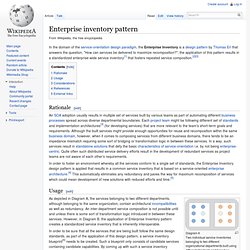
Each project team might be following different set of standards and implementation architectures[3] (for developing services) that are more relevant to the team's short-term goals and requirements. Although the built services might provide enough opportunities for reuse and recomposition within the same business domain, however, when it comes to composing services from different business domains, there tends to be an impedance mismatch requiring some sort of bridging or transformation logic in between these services.
In a way, such services result in standalone solutions that defy the basic characteristics of service-orientation i.e. by not being enterprise-centric. DeveloperWorks : SOA & web services : Technical library.
Spring. Imac. Domain inventory pattern. Rationale[edit] As per the guidelines of the Enterprise Inventory design pattern, it is beneficial to create a single inventory that spans the whole of the enterprise as it results in services that are more standardized, interoperable and easily composable.
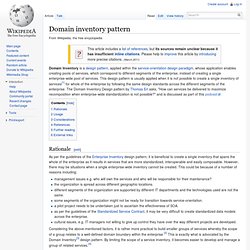
However, there may be situations when a single enterprise-wide inventory cannot be created. This could be because of a number of reasons including: management issues e.g. who will own the services and who will be responsible for their maintenance? Service Normalization Pattern. Rationale[edit] When different teams are delivering multiple services as part of automating various business processes, there is a possibility that some of these services might end up having duplicate functionality.
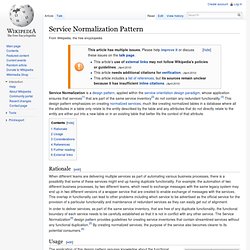
For example, the automation of two different business processes, by two different teams, which need to exchange messages with the same legacy system may end up in two different versions of a wrapper service that are created to enable exchange of messages with the services. Logic centralization pattern. Rationale[edit] As more and more services are developed, there is a constant risk that services with redundant functionality may be created.
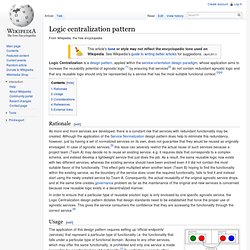
Although the application of the Service Normalization design pattern does help to eliminate this redundancy, however, just by having a set of normalized services on its own, does not guarantee that they would be reused as originally envisaged. In case of agnostic services,[5] this issue can severely restrict the actual reuse of such services because a project team (Team A) may decide no to reuse an existing service, e.g. it requires data that corresponds to a complex schema, and instead develop a lightweight service that just does the job. As a result, the same reusable logic now exists with two different services, whereas the existing service should have been evolved even if it did not contain the most suitable flavor of the functionality. Canonical protocol pattern. Rationale[edit] In order to design a service inventory where all services are interoperable with each other so that they can be composed into different solutions, the application of the Canonical Protocol pattern dictates standardizing the communication protocols used by the services.
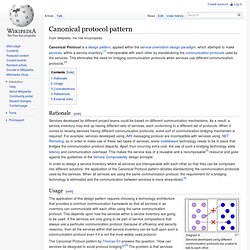
When all services are using the same communication protocol, the requirement for a bridging technology is eliminated and the communication between services is more streamlined.[4] Usage[edit] Diagram A Services developed using different communication protocols are unable to talk to each other. Diagram B Services developed using the same communication protocols are able to talk to each other and hence can be used in multiple service compositions. Service layers pattern. Rationale[edit] Grouping services into functional layers reduces the impact of change.

Most changes affect only the layer in which they're made, with few side-effects that impact other layers. Canonical schema pattern. Rationale[edit] The interaction between services often requires exchanging business documents.
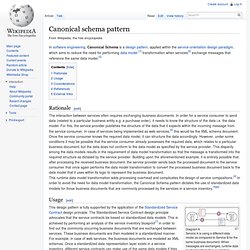
In order for a service consumer to send data (related to a particular business entity e.g. a purchase order), it needs to know the structure of the data i.e. the data model. For this, the service provider publishes the structure of the data that it expects within the incoming message from the service consumer. In case of services being implemented as web services,[2] this would be the XML schema document.
Once the service consumer knows the required data model, it can structure the data accordingly. Service Facade decouples contract, core logic: SOA Pattern (Week 1) Thomas Erl, SOASchool.com and Herbjörn Wilhelmsen, Objectware When you register, you'll begin receiving targeted emails from my team of award-winning writers.

Our goal is to keep you informed on recent service-oriented architecture (SOA) and SOA-related topics such as integration, governance, Web services, Cloud and more. One of the fundamental goals when designing service-oriented solutions is to attain a reduced degree of coupling between services, thereby increasing the freedom and flexibility with which services can be individually evolved. Achieving the right level of coupling "looseness" is most often considered a design issue that revolves around the service contract and the consumer programs that form dependencies upon it.
When designing a service, there are several negative coupling types you need to look out for. SOA Patterns - Master Pattern List (Category) SOA Patterns: Basic Structural Patterns – Part 3. This article is based on the book SOA Patterns ( scheduled to print February 2009.
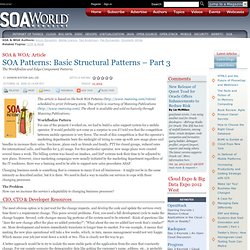
This article is courtesy of Manning Publications ( The ebook is available and sold exclusively through Manning Publications. Workflodize PatternFor one of the projects I worked on, we had to build a sales support system for a mobile operator. It would probably not come as a surprise to you if I told you that the competition between mobile operators is very fierce. The result of this competition is that the operator's marketing departments burn the midnight oil trying to come up with new usage plans and bundles to increase their sales. You know, plans such as friends and family, PTT for closed groups, reduced rates for international calls, and bundles for 3.5G usage.
Changing business needs is something that is common to many if not all businesses - it might not be in the same intensity as described earlier, but it is there. SOA Patterns: Basic Structural Patterns – Part 2. SOA Patterns: Basic Structural Patterns - Part 1. This article is based on the book SOA Patterns ( scheduled to print February 2009.
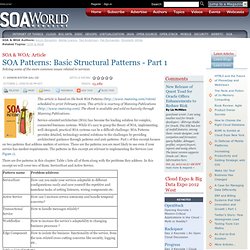
This article is courtesy of Manning Publications ( The ebook is available and sold exclusively through Manning Publications. Service-oriented architecture (SOA) has become the leading solution for complex, connected business systems. While it's easy to grasp the theory of SOA, implementing well-designed, practical SOA systems can be a difficult challenge. SOA Patterns provides detailed, technology-neutral solutions to the challenges by providing architectural guidance through patterns and anti-patterns.
SOADesignPatternsPoster-A2. Patterns from SOA Design Patterns by Thomas Erl, Part 1. The first draft of SOA Design Patterns had 60 patterns that were reviewed by more than 100 selected SOA specialists from all over the world. During the same time the draft was subject to public review on soapatterns.org. The SOA community was invited to contribute with their own patterns, ones they had used and had been validated in production. 10 Soa Design Patterns Every Architect Should Know. These 10 SOA design patterns are so important and widely used that they almost seem a little obvious. 1.
Agnostic Services Agnostic services implement logic that is common to multiple business problems. Separating agnostic logic into discrete services facilitates service reuse and composability. principles: reuse, service composability. Patterns from "SOA Design Patterns" by Thomas Erl, Part 2. We continue to present patterns from Thomas Erl’s book, “SOA Design Patterns”. In Part 1, we presented three Inventory Governance Patterns from chapter 10. Today, we present Chapter 16, Service Governance Patterns, comprising a number of 8 patters.
Compatible Change and Version Identification deal with service versioning.